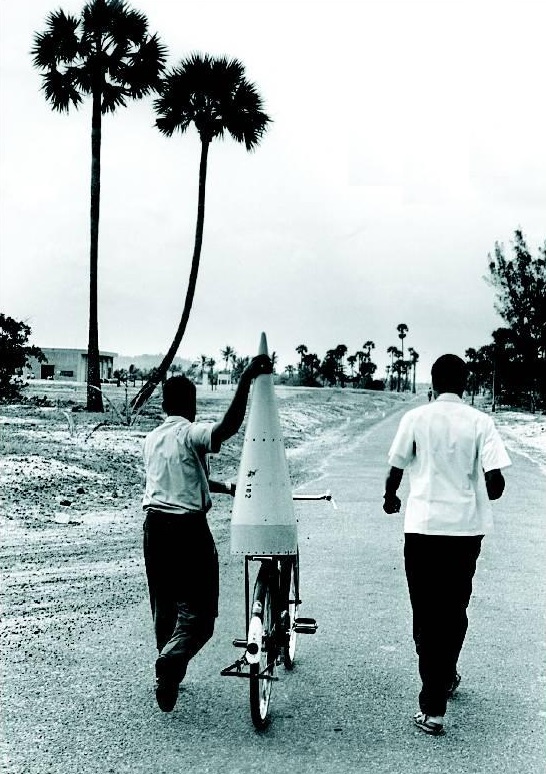
Rockets being brought on a bicycle to Thumba.
Then President late A P J Abdul Kalam had an interesting tale to tell. Prof Vikram Sarabhai met many politicians and bureaucrats to get the place to set up an establishment for space science research work in Thumba, a small fishing hamlet near Thiruvananthapuram.
However, he could not succeed because at the site stood a large and ancient church of St Mary Magdalene, which was founded in a thatched shed in 1544 by St Francis Xavier, and also a Bishop's House, whose site had to be acquired.
He was then asked to see the Bishop of Thiruvananthapuram Peter Bernard Pereira. It was a Saturday when Prof Sarabhai met the Bishop. Instead of giving them a definite answer, the smiling Bishop asked them to attend Sunday Mass, where he would put the question to the parishioners. At the Mass, the Bishop explained the scientific mission and asked permission from his congregation to hand over the church to the scientists.
The Bishop told the congregation, "My children, I have a famous scientist Vikram with me who wants our church and the place I live for the work of space science research. Dear children, science seeks the truth that enriches human life. The higher level of religion is spirituality. Spiritual preachers like me, seek the help of the Almighty to bring peace to human minds. In short, what Vikram is doing and what I am doing are the same - both science and spirituality seek the Almighty’s blessings for human prosperity in mind and body. Vikram Sarabhai promises within six months, our abode and church will be newly built and given to us. Children, can we give them God’s abode, my abode, and your abode for a scientific mission?”
There was a pin-drop silence for a while, followed by a hearty “Amen” from the congregation, which made the whole church reverberate!
Subsequently, the big event took place in 1962. Bishop Pereira took the noble decision to dedicate the church to set up the Thumba Equatorial Rocket Launching Station (TERLS) at Pallithura, Thumba.
The bishop’s home was quickly converted into an office, the church became the workshop, and cattle sheds served as storage houses and laboratories. Undeterred by the little funding and few facilities, a handful of enthusiastic young Indian scientists began assembling their first rocket.
“We made that church our design centre, started rocket assembly; design of filament winding machine for FRP product and the Bishop's house was our design centre. Later, TERLS led to the establishment of Vikram Sarabhai Space Centre (VSSC) and multiple space centres throughout the country,” Kalam related.
Legend has it that the altar served as the design table and the bishop’s house the living quarters!
BUILDING BRIDGES
In return for the generous, unquestioning support of Bishop Pereira and his parish, ISRO built two churches for them near Thumba. The villagers were relocated to a new village with a brand new church in 100 days flat.
Kalam elaborated, “When I think of that event, I can see how enlightened spiritual and scientific leaders; all converge towards giving reverence to the meaning of human life. New churches and new schools were established in record time.”
Of course, the birth of TERLS and then VSSC gave the country the capability to design, develop and produce a huge world-class rocket system.
Twenty newly-recruited scientists handpicked by Satish Dhawan, Vikram Sarabhai and Vasant Gowarikar were busy with their laboratory work at a cowshed behind the Magdalene church.
Kalam was not expected to be part of the team to launch India’s first rocket from the Thumba equatorial launching station (now VSSC). The young man convinced the interviewers about his passion towards rocket technology and they created an additional post to accommodate him in their team.
Thus, Kalam came to be associated with INCOSPAR which would become the Indian Space Research Organisation (ISRO). Thumba being the hub of all research activities became Kalam’s home for 21 years.
Kalam, concluded, "Today, among us, Prof Vikram Sarabhai is not there nor is Rev Peter Bernard Pereira, but those who are responsible for the creation and make the flower blossom, will themselves be a different kind of a flower of unique fragrance,” urging young Indians to help build the country.
That giant leap of faith began in a church. Now, India has the capability of standing shoulder-to-shoulder with other developed countries who have launched space missions on their own, a feat only select countries have achieved. Thanks to the large-heartedness of simple parishioners of St Mary Magdalene Church, Thumba.
[The writer is editor of the online publication Indian Catholic Matters]